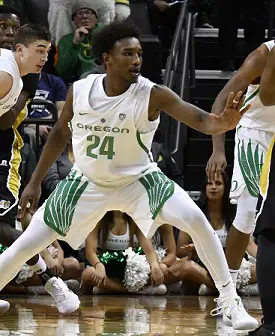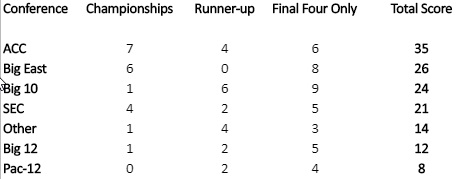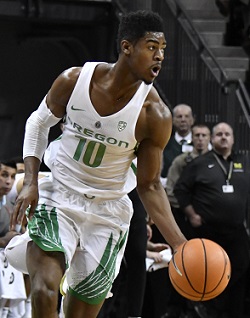The 2018 Oregon Ducks basketball season ended with a big thud last weekend. And while it would have been nice to see the Ducks make a run in the NIT, I get the feeling that Duck fans didn’t lose sleep over losing in the second round. With five straight NCAA Tournament appearances, Oregon fans have become accustomed to getting more out of their basketball team.
The Ducks finished the season with a 23-13 record. It’s Oregon’s lowest win total since Dana Altman’s first season in 2010-11. But, with the recent five-year tournament run, last year’s Final Four fininsh, and the second-rated recruiting class in the nation coming in next season, most are viewing this season as a forgivable one year write-off.
Here are three questions coming into what most predict will be a big year next season:

Will Abu Kigab raise his game in year 2?
1) Will the Ducks find their “dog?”
I went in depth with this last week (here), The 2018 version of the Ducks consisted of a solid cast of role players without a go-to stud performer (a “PTP-er,” as Dick Vitale would say). After having that “guy” for several straight seasons, we got to witness first-hand just how benign the Ducks were without him.
Speaking of potential go-to players …
2) Will Troy Brown go pro?
He’s projected to go in the second half of the first round. While he showed flashes of his first-round abilities, Brown ultimately struggled to find a rhythm within the team and his outside shot. Without question, he could use more seasoning and a full college off-season to prepare himself as Oregon’s go-to “dog” player entering next season (think Dillon Brooks here). But a truck-load of money is always tough to turn down, at least from what I’m told.
3) How will the nation’s No. 2 recruiting class perform?
Some five-star players come in and lead their team to a stellar season and become a top-ten NBA draft picks, while others struggle to find their game against a higher level of competition. It’s honestly hard to predict. With two of the top-20 recruits and four of the top-60, one would have to believe that at least one of these freshmen steps in as an immediate difference maker. Hopefully three or four.
The Pac-12’s Basketball Drought
The Pac-12 Conference has not won a basketball title in over 20 years. The chart below illustrates how the the Pac-12 compares to other conferences beginning in 1998, the year after Arizona won it all.
(Points are calculated as so: champion gets three points, runner-up gets two, and making the Final Four gets a conference one point. I’m sure there’s a better system out there, but here we go … )

Conference affiliation is based on which conference they were in at the time of their achievement. For example, Runner-up Utah was in the WAC in 1998, so they fell into the “other” category, not the Pac-12.
For those that are arithmetically challenged, the Pac-12 is dead last, and is the only conference with a point total in the single digits!
Pac-12 Notes: Basketball
A) Once a Cougar, always a Cougar. At least those were the words cycling through my head as I watched Tony Bennett’s Virginia Cavaliers become the first No. 1 seed to lose — okay, get blown out — to a No. 16 seed. Bennett, of course, coached Washington State from 2006-2009, and there’s no other way to describe it other than he “Couged-it.” As they say, you can take the boy out of Pullman, but you can’t take the Pullman out of the boy (more on “Couging-it” here).
B) The disaster that was Pac-12 basketball. Three teams make the tournament, but only one actually played in the round of 64, as UCLA and Arizona State both lost play-in games. This left Arizona as the only team to truly be in the regular field … I guess. The No. 4 seed ‘Cats got smoked by No. 13 seed Buffalo. You could say the Pac-12 “Couged-it” in this year’s Big Dance.

Victor Bailey Jr. was red-hot against Rider in the NIT.
C) The NCAA tournament payout is measured in units. From 2015-2017, the Pac-12 averaged 12 units per year. A team making the tournament counts as one unit, and each victory thereafter also counts as a unit. From 2015-17, the conference averaged 12 units per tournament. This year it got only three. To make a long story short, going from 12 to three units will cost each school about $1.3 million.
D) With the Arizona Wildcats caught up in the college basketball pay-for-play scandal and hemorrhaging key recruits, it’s likely that the Wildcats will not be earning as many units in the coming years. This is not good for the bottom-line of the conference or the Ducks.
E) A task-force headed by Pac-12 Commissioner Larry Scott calls for the NBA to end the one-and-done rule. The new rule would follow the model that Major League Baseball has in place, where high-school players can enter the draft right out of school. Those who are not drafted would not be eligible for the draft again until completing three years of college. Safe to say that if that rule was in effect today, the Ducks would definitely not be getting five-star prospect Bol Bol, and probably not Louis King.
Perhaps eliminating the one-and-done rule is the key to the Pac-12 ending its hoops drought. Allowing the likes of Dana Altman — who historically hasn’t gotten elite talent — to coach up a solid core of players for at least three years at a time could reap significant rewards. Maybe one day we’ll all find out.
Nevertheless, what we know is that the Conference of Champions has become the Conference of Champions in Every Sport Except Our Two Favorites: football and basketball. Yikes. Here’s to better days ahead.
Darren Perkins
Spokane, WA
Top photo credit: Eugene Johnson
Related Articles:
Oregon Enters Playoffs Better Off Than Last Year
Will The Coaching Carousel Kill Oregon's CFP Chances?
The Playoff Formula Hasn't Changed
Oregon Aims to Bury Dawgs, Punch Playoff Ticket in Rivalry Clash
Huskies Are the New Beavers, Stay In Your Lane Kiffin, and the Civil Apple Cup War
Oregon Football: The X-Factor Vs. Washington
Darren Perkins is a sales professional and 1997 Oregon graduate. After finishing school, he escaped the rain and moved to sunny Southern California where he studied screenwriting for two years at UCLA. Darren grew up in Eugene and in 1980, at the tender age of five, he attended his first Oregon football game. His lasting memory from that experience was an enthusiastic Don Essig announcing to the crowd: “Reggie Ogburn, completes a pass to… Reggie Ogburn.” Captivated by such a thrilling play, Darren’s been hooked on Oregon football ever since. Currently living in Spokane, Darren enjoys flaunting his yellow and green superiority complex over friends and family in Cougar country.

